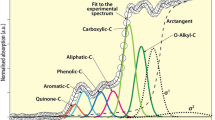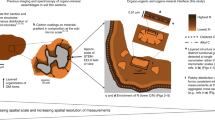Abstract
Organic matter in soil has been suggested to be composed of a complex mixture of identifiable biopolymers1 rather than a chemically complex humic material2. Despite the importance of the spatial arrangement of organic matter forms in soil3, its characterization has been hampered by the lack of a method for analysis at fine scales. X-ray spectromicroscopy has enabled the identification of spatial variability of organic matter forms, but was limited to extracted soil particles4 and individual micropores within aggregates5,6. Here, we use synchrotron-based near-edge X-ray spectromicroscopy7 of thin sections of entire and intact free microaggregates6 to demonstrate that on spatial scales below 50 nm resolution, highly variable yet identifiable organic matter forms, such as plant or microbial biopolymers, can be found in soils at distinct locations of the mineral assemblage. Organic carbon forms detected at this spatial scale had no similarity to organic carbon forms of total soil. In contrast, we find that organic carbon forms of total soil were remarkably similar between soils from several temperate and tropical forests with very distinct vegetation composition and soil mineralogy. Spatial information on soil organic matter forms at the scale provided here could help to identify processes of organic matter cycling in soil, such as carbon stability or sequestration and responses to a changing climate.
This is a preview of subscription content, access via your institution
Access options
Subscribe to this journal
Receive 12 print issues and online access
$259.00 per year
only $21.58 per issue
Buy this article
- Purchase on Springer Link
- Instant access to full article PDF
Prices may be subject to local taxes which are calculated during checkout




Similar content being viewed by others
References
Kelleher, B. P. & Simpson, A. J. Humic substances in soils: Are they really chemically distinct? Environ. Sci. Technol. 40, 4605–4611 (2006).
Stevenson, F. Humus Chemistry: Genesis, Composition, Reactions (Wiley, New York, 1994).
Young, I. M. & Crawford, J. W. Interactions and self-organization in the soil-microbe complex. Science 304, 1634–1637 (2004).
Schumacher, M., Christl, I., Scheinost, A. C., Jacobsen, C. & Kretzschmar, R. Chemical heterogeneity of organic soil colloids investigated by scanning transmission X-ray microscopy and C-1s NEXAFS microspectroscopy. Environ. Sci. Technol. 39, 9094–9100 (2005).
Kinyangi, J. et al. Nanoscale biogeocomplexity of the organo-mineral assemblage in soil: Application of STXM microscopy and C 1s-NEXAFS spectroscopy. Soil Sci. Soc. Am. J. 70, 1708–1718 (2006).
Lehmann, J., Kinyangi, J. & Solomon, D. Organic matter stabilization in soil microaggregates: Implications from spatial heterogeneity of organic carbon contents and carbon forms. Biogeochemistry 85, 45–57 (2007).
Jacobsen, C., Wirick, S., Flynn, G. & Zimba, C. Soft X-ray spectroscopy from image sequences with sub-100 nm spatial resolution. J. Microsc. 197, 173–184 (2000).
Achard, F. K. Chemische untersuchung des torfs. Crell’s Chem. Ann. 2, 391–403 (1786).
Kleber, M., Sollins, P. & Sutton, R. A conceptual model of organo-mineral interactions in soils: Self-assembly of organic molecular fragments into zonal structures of mineral surfaces. Biogeochemistry 85, 9–24 (2007).
Davidson, E. A. & Janssens, I. A. Temperature sensitivity of soil carbon decomposition and feedbacks to climate change. Nature 440, 165–173 (2006).
Brandes, J. A. et al. Examining marine particulate organic matter at sub-micron scales using scanning transmission X-ray microscopy and carbon X-ray absorption near edge structure spectroscopy. Mar. Chem. 92, 107–121 (2004).
Ade, H. et al. Chemical contrast in X-ray microscopy and spatially resolved XANES spectroscopy of organic specimens. Science 258, 972–975 (1992).
Lehmann, J. et al. Near-edge X-ray absorption fine structure (NEXAFS) spectroscopy for mapping nano-scale distribution of organic carbon forms in soil: Application to black carbon particles. Glob. Biogeochem. Cycles 19, 1013–1025 (2005).
Liang, B. et al. Black carbon increases cation exchange capacity in soils. Soil Sci. Soc. Am. J. 70, 1719–1730 (2006).
Solomon, D., Lehmann, J., Kinyangi, J., Liang, B. & Schäfer, T. Carbon K-edge NEXAFS and FTIR-ATR spectroscopic investigation of organic carbon speciation in soils. Soil Sci. Soc. Am. J. 69, 107–119 (2005).
Solomon, D. et al. Long-term impacts of anthropogenic perturbations on the dynamics and molecular speciation of organic carbon in tropical forest and subtropical grassland ecosystems. Glob. Change Biol. 13, 511–530 (2007).
Lawrence, J. R. et al. Scanning transmission X-ray, laser scanning, and transmission electron microscopy mapping of the exopolymeric matrix of microbial biofilms. Appl. Environ. Microbiol. 69, 5543–5554 (2003).
Franklin, R. B. & Mills, A. L. Multi-scale variation in spatial heterogeneity for microbial community structure in an eastern Virginia agricultural field. FEMS Microbiol. Ecol. 44, 335–346 (2003).
Foster, R. C. Microenvironments of soil microorganisms. Biol. Fert. Soils 6, 189–203 (1988).
Torn, M. S., Trumbore, S. E., Chadwick, O. A., Vitousek, P. M. & Hendricks, D. M. Mineral control of soil organic carbon storage and turnover. Nature 389, 170–173 (1997).
Schmidt, M. W. I. & Noack, A. G. Black carbon in soils and sediments: Analysis, distribution, implications, and current challenges. Glob. Biogeochem. Cycles 14, 777–794 (2000).
Yavitt, J. B. Nutrient dynamics of soil derived from different parent material on Barro Colorado Island, Panama. Biotropica 32, 198–207 (2000).
Lehmann, J., Cravo, M. S. & Zech, W. Organic matter stabilization in a Xanthic Ferralsol of the central Amazon as affected by single trees: Chemical characterization of density, aggregate and particle size fractions. Geoderma 99, 147–168 (2001).
Richardson, S. J., Peltzer, D. A., Allen, R. B., McGlone, M. S. & Parfitt, R. L. Rapid development of phosphorus limitation in temperate rainforest along the Franz Josef soil chronosequence. Oecologia 139, 267–276 (2004).
Sohi, S., Mahieu, N., Arah, J. R. M., Madari, B. & Gaunt, J. L. A procedure for isolating soil organic matter fractions suitable for modeling. Soil Sci. Soc. Am. J. 65, 1121–1128 (2001).
Watts, B., Thomson, L. & Dastoor, P. C. Methods in carbon k-edge NEXAFS: Experiment and analysis. J. Electron. Spectrosc. Relat. Phenom. 151, 105–120 (2006).
Ravel, B. & Newville, M. ATHENA and ARTEMIS: Interactive graphical data analysis using IFEFFIT. Phys. Scr. 115, 1007–1010 (2005).
Lerotic, M., Jacobsen, C., Schäfer, T. & Vogt, S. Cluster analysis of soft X-ray spectromicroscopy data. Ultramicroscopy 100, 35–57 (2004).
Lerotic, M. et al. Cluster analysis in soft X-ray spectromicroscopy: Finding the patterns in complex specimens. J. Electron Spectrosc. Relat. Phenom. 144–147C, 1137–1143 (2005).
Acknowledgements
This research was financially supported in part by NSF-CHNS and NSF-DEB. Any opinions, findings and conclusions or recommendations expressed in this material are those of the authors and do not necessarily reflect the views of the NSF. The Beamline X-1A1 at the National Synchrotron Light Source (NSLS) was developed by the research group of J. Kirz and C. Jacobsen at SUNY, Stony Brook, with support from DoE and NSF-DBI and -ECS. The Canadian Light Source (CSL) is supported by NSERC, NRC, CIHR and the University of Saskatchewan. Thanks to K. Hanley, K. Heyman, T. Fahey, B. Turner, J. Yavitt, Y. Zhang, R. Blyth and T. Regier for help in preparing, providing or measuring the samples.
Author information
Authors and Affiliations
Contributions
J.L. planned the study, conducted the X-ray measurements, analysed the data and developed the paper. D.S., J.K. and L.D. prepared the samples and provided input to the manuscript. S.W. and C.J. aided in X-ray and data analyses and commented on the manuscript.
Corresponding author
Supplementary information
Supplementary Information
Supplementary figures S1-S6 (PDF 1616 kb)
Rights and permissions
About this article
Cite this article
Lehmann, J., Solomon, D., Kinyangi, J. et al. Spatial complexity of soil organic matter forms at nanometre scales. Nature Geosci 1, 238–242 (2008). https://doi.org/10.1038/ngeo155
Received:
Accepted:
Published:
Issue Date:
DOI: https://doi.org/10.1038/ngeo155
This article is cited by
-
“Reactive Mineral Sink” drives soil organic matter dynamics and stabilization
npj Materials Sustainability (2023)
-
Associations of soil Fe oxides and organic carbon vary in different aggregate fractions under warming
Journal of Soils and Sediments (2023)
-
Agroforestry can improve soil fertility and aggregate-associated carbon in highland soils in the Brazilian northeast
Agroforestry Systems (2023)
-
Combined effects of earthworms and biochar on PAHs-contaminated soil remediation: A review
Soil Ecology Letters (2023)
-
Current controversies on mechanisms controlling soil carbon storage: implications for interactions with practitioners and policy-makers. A review
Agronomy for Sustainable Development (2023)



